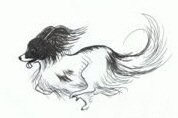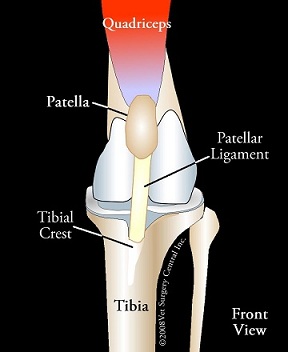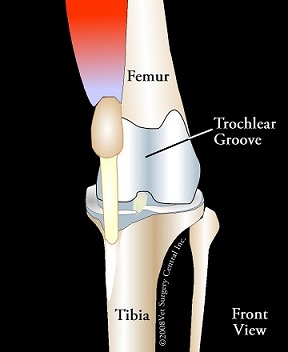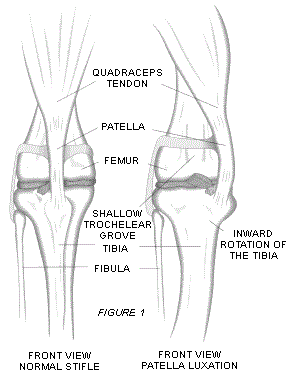

The knee (stifle) is a complex joint joining the thigh bone (femur) and the shin bone (tibia) together. In the front of the joint, the kneecap or patella is a small bone embedded in the patella ligament. It travels in a groove (trochlear groove) on the front of the femur. The purpose of the patella is to help stabilize the joint and keep the femur and tibia in proper alignment. In normal animals, the ridges of the trochlear groove are high enough to prevent movement of the patella to the inside or outside of the groove. In some pets, particularly small breed dogs, the trochlear groove may be very shallow on one or both sides. This can predispose the pet to have the kneecap move (luxate) to the inside or outside of the leg. When this happens, there are a number of problems that develop:
 Each time the patella luxates out of the groove, the joint becomes inflamed and painful. With time, osteoarthritis will develop.
Each time the patella luxates out of the groove, the joint becomes inflamed and painful. With time, osteoarthritis will develop.
 When the patella is out of position, the knee becomes unstable and damage to other structures in the knee may occur.
When the patella is out of position, the knee becomes unstable and damage to other structures in the knee may occur.
 The luxated patella and its tendon may act like a bowstring, preventing the pet from straightening the leg.
The luxated patella and its tendon may act like a bowstring, preventing the pet from straightening the leg.


What are the symptoms of patella luxation?
Pets experiencing patella luxation will often have a sudden onset of lameness in the affected hind leg. Frequently, they will hold the leg up for a few steps and then suddenly appear to walk more normally due to the fact that the patella may have slipped back into its normal position. For pets that are born with the defect, or have had it for some time, the knee may not be able to fully extend and it may appear that the pet is always bending the leg.
How do we diagnose patella luxation?
The diagnosis of patella luxation is based on the history given by the owner, observation of the pet's gait, palpation (physical manipulation of the joint) and radiographs (x-rays) of the affected leg. On palpation, the patella can be pushed out of its normal position with varying degrees of ease. Radiographs will show the patella out of its normal position and may show evidence of arthritis.
Four grades of luxation are recognized:
Grade I: The patella luxates with manual pressure and returns spontaneously.
Grade II: The patella luxates with flexion and extension of the joint, but returns to the trochlear groove spontaneously. Some lameness may be present.
Grade III: The patella luxates with flexion and extension of the joint, but can be reduced manually. Considerable lameness exists.
Grade IV: The patella is permanently luxated to the medial side. The limb or limbs are unable to extend and the animal walks balancing its weight on the forelimbs.
How do we treat patella luxation? Patella luxation can only be corrected through surgery. During the surgery, the joint is opened and all of the internal structures of the knee are inspected for damage. Any damaged structures are repaired if possible. Then the trochlear groove in the femur is deepened by removing some of the bone. The patella is replaced in its normal position and the joint capsule is tightened in such a way as to limit the mobility of the patella. In some cases, the point of insertion of the patella ligament on the tibia is moved to a position that will reduce the forces that tend to pull it out of its normal alignment. After the surgery, the pets are usually placed in a splint for 1-2 weeks to help support the knee during the healing phase. Antibiotics, anti-inflammatory and joint protecting drugs are dispensed to reduce the chance of infection, and to reduce pain and inflammation. The splint is changed 7 days after the surgery and the incision is inspected. The splint and skin sutures or staples are removed 14 days post operatively. At this point, the owners are instructed in simple physical therapy techniques to help return full function to the knee. It usually takes between 4 to 6 weeks for the pet to return to full function | What is the prognosis for patella luxation? Treatment for patella luxation is very rewarding if done early in the course of the disease, prior to the onset of osteoarthritis. Pets treated early on can expect and 85 to 100% return to function. Once the knee has developed arthritis, the surgery will still help considerably, but the arthritis that has already developed will not fully reverse itself. Therefore, we recommend that pets diagnosed with this problem should have surgery as soon as possible, even if they are not showing symptoms currently |